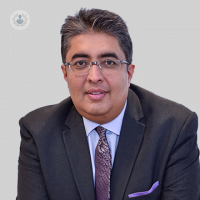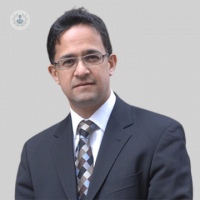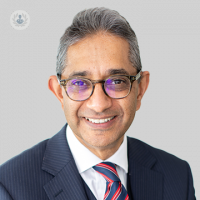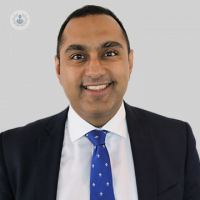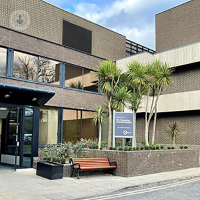What is facial plastic surgery?
Facial plastic surgery is a broad term covering cosmetic or reconstructive surgery performed on the head and neck. A facial plastic surgeon has a strong knowledge of facial anatomy and is highly skilled in procedures concerning the head and neck, either cosmetic or reconstructive.
Specialised plastic surgeons are not the only doctors who may be suitably trained to perform facial plastic surgery. It may be performed by otolaryngology (ENT) surgeons (whose background is conditions of the ear, nose, throat, and related structures of the head and neck), maxillofacial surgeons (who specialise in surgery of the face and jaw), ophthalmologists (who specialise in treating the eyes) and dermatologists (skin doctors).

Common procedures performed by facial plastic surgeons include:
- Rhinoplasty (nose job)
- Neck lift
- Facelift
- Otoplasty (ear surgery)
- Blepharoplasty (eyelid surgery)
- Chin augmentation
Why is it done?
Depending on what it is used for, facial plastic surgery procedures can be divided into two main groups: reconstructive or restorative surgery and aesthetic or cosmetic surgery.
- Reconstructive/restorative surgery (including microsurgery) is focused on disguising the effects of an accident or trauma, congenital anomalies and facial tumours.
- Aesthetic or cosmetic surgery usually treats healthy patients and is done to modify the parts of the face that the patient is not happy with in order to improve their quality of life. Some procedures that are done for aesthetic reasons may also serve functional purposes such as blepharoplasty to improve vision or rhinoplasty to help the patient to breathe more easily.
What does it involve?
The intervention required will depend on the case. First, the the specialist surgeon will assess the patient’s situation and explain the options, including the pre and post-operative process and the results that the patient can expect.
It is very important that in the whole process there is good communication between the surgeon and patient to make sure the patient understands the process, the risks involved and realistic outcomes.
How to prepare for facial plastic surgery
Before the surgery, the specialist may perform tests to check the patient's health and to ensure that he or she can undergo the procedure.
The type of anesthesia, the duration of the intervention and the risks will depend on each particular case.
Care after the intervention
The post-operative care of the intervention will depend on each type of surgery, although in most facial interventions a rest period is necessary after leaving the operating room.
It is also characteristic of facial plastic surgery procedures that swelling develops in the treated area. The final results will take weeks or even months to show, as the inflammation subsides.
11-13-2012 04-26-2023Facial plastic surgery
Miss Natasha Berridge - Oral & maxillofacial surgery
Created on: 11-13-2012
Updated on: 04-26-2023
Edited by: Conor Dunworth
What is facial plastic surgery?
Facial plastic surgery is a broad term covering cosmetic or reconstructive surgery performed on the head and neck. A facial plastic surgeon has a strong knowledge of facial anatomy and is highly skilled in procedures concerning the head and neck, either cosmetic or reconstructive.
Specialised plastic surgeons are not the only doctors who may be suitably trained to perform facial plastic surgery. It may be performed by otolaryngology (ENT) surgeons (whose background is conditions of the ear, nose, throat, and related structures of the head and neck), maxillofacial surgeons (who specialise in surgery of the face and jaw), ophthalmologists (who specialise in treating the eyes) and dermatologists (skin doctors).

Common procedures performed by facial plastic surgeons include:
- Rhinoplasty (nose job)
- Neck lift
- Facelift
- Otoplasty (ear surgery)
- Blepharoplasty (eyelid surgery)
- Chin augmentation
Why is it done?
Depending on what it is used for, facial plastic surgery procedures can be divided into two main groups: reconstructive or restorative surgery and aesthetic or cosmetic surgery.
- Reconstructive/restorative surgery (including microsurgery) is focused on disguising the effects of an accident or trauma, congenital anomalies and facial tumours.
- Aesthetic or cosmetic surgery usually treats healthy patients and is done to modify the parts of the face that the patient is not happy with in order to improve their quality of life. Some procedures that are done for aesthetic reasons may also serve functional purposes such as blepharoplasty to improve vision or rhinoplasty to help the patient to breathe more easily.
What does it involve?
The intervention required will depend on the case. First, the the specialist surgeon will assess the patient’s situation and explain the options, including the pre and post-operative process and the results that the patient can expect.
It is very important that in the whole process there is good communication between the surgeon and patient to make sure the patient understands the process, the risks involved and realistic outcomes.
How to prepare for facial plastic surgery
Before the surgery, the specialist may perform tests to check the patient's health and to ensure that he or she can undergo the procedure.
The type of anesthesia, the duration of the intervention and the risks will depend on each particular case.
Care after the intervention
The post-operative care of the intervention will depend on each type of surgery, although in most facial interventions a rest period is necessary after leaving the operating room.
It is also characteristic of facial plastic surgery procedures that swelling develops in the treated area. The final results will take weeks or even months to show, as the inflammation subsides.
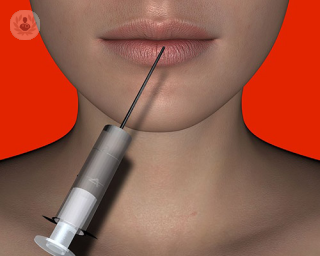

What is the difference between Botox and dermal fillers?
By Mr Kambiz Golchin
2024-11-21
What is Botox? What are dermal fillers? What is the difference between the two? Find out in this guide to two of the most popular cosmetic treatments available from top doctor Kambiz Golchin. See more


18 things to expect after a rhinoplasty or septorhinoplasty operation with Professor Malata
By Professor Charles Malata
2024-11-21
After undergoing a rhinoplasty or septorhinoplasty, it is important to fully understand the steps you need to follow to hasten your recovery and avoid any unnecessary complications. Professor Charles Malata, an expert consultant plastic surgeon, lists exactly what to expect after waking up from your operation and at what point you'll be able to see your new nose for the first time. See more
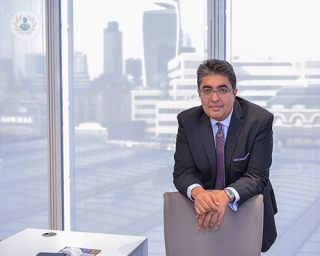

ENT surgeon Mr Santdeep Paun - being a Top Doctor
By Mr Santdeep Paun
2024-11-21
Mr Santdeep Paun is a leading ENT (otolaryngology) surgeon who specialises in nasal and facial plastic surgery. He is based in a selection of well-known clinics across central London, including his clinics on Harley Street and at St Bartholomew’s Hospital. We spoke to Mr Santdeep Paun about why he chose to become a doctor and to become a specialist in ENT surgery. See more
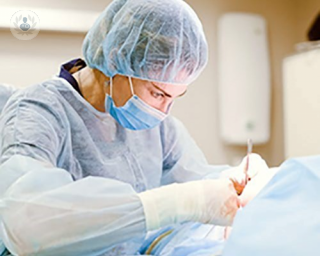

Exploring the world of facial plastic surgery
By Mr Matthew James
2024-11-20
In his latest online article, Mr Matthew James gives us his insights into cosmetic and reconstructive surgery. He talks about the difference between the two, how a patient can prepare for surgery, what’s involved in the procedure and how long the recovery is. See more
Experts in Facial plastic surgery
-
Mr Santdeep Paun
Otolaryngology / ENTExpert in:
- Rhinoplasty (nose job)
- Septorhinoplasty
- Facelift
- Earfold®
- Nasal trauma
- Otoplasty
-
Mr Jonathan Britto
Plastic surgeryExpert in:
- Blepharoplasty
- Facelift
- Facial paralysis
- Mid face lift
- Facial plastic surgery
- Rhinoplasty (nose job)
-
Mr Bhavin G Visavadia
Oral & maxillofacial surgeryExpert in:
- Facial plastic surgery
- Dental implants
- Facial reconstruction
- Head and neck cancer
- Oral surgery
- Salivary gland surgery
-
Mr Anil Joshi
Otolaryngology / ENTExpert in:
- Rhinoplasty (nose job)
- Endoscopic sinus surgery
- Otoplasty
- Facial plastic surgery
- Skin cancer
- Paediatric ENT
-
Mr Raj Lakhani
Otolaryngology / ENTExpert in:
- Rhinoplasty (nose job)
- Endoscopic sinus surgery
- Paediatric ENT
- Snoring
- Tonsillitis
- Facial plastic surgery
- See all

The Clementine Churchill Hospital - part of Circle Health Group
The Clementine Churchill Hospital - part of Circle Health Group
Sudbury Hill, Harrow HA1 3RX
No existe teléfono en el centro.
By using the telephone number provided by TOP DOCTORS, you automatically agree to let us use your phone number for statistical and commercial purposes. For further information, read our Privacy Policy
Top Doctors

New Victoria Hospital
New Victoria Hospital
184 Coombe Lane West, Kingston upon Thames, KT2 7EG
No existe teléfono en el centro.
By using the telephone number provided by TOP DOCTORS, you automatically agree to let us use your phone number for statistical and commercial purposes. For further information, read our Privacy Policy
Top Doctors

The Harley Street ENT Clinic
The Harley Street ENT Clinic
109 Harley Street, London, W1G 6AN
No existe teléfono en el centro.
By using the telephone number provided by TOP DOCTORS, you automatically agree to let us use your phone number for statistical and commercial purposes. For further information, read our Privacy Policy
Top Doctors
-
The Clementine Churchill Hospital - part of Circle Health Group
Sudbury Hill, Harrow HA1 3RX, West LondonExpert in:
- Abdominal ultrasound
- Abdominoplasty
- Acne
- Allergies bronchopulmonary
- Allergies nose and ears
- Allergy Dermatitis
-
New Victoria Hospital
184 Coombe Lane West, Kingston upon Thames, KT2 7EG, South LondonExpert in:
- Cardiology
- General Surgery
- Orthopaedic surgery
- Breast augmentation
- Pain management
- Spine
-
The Harley Street ENT Clinic
109 Harley Street, London, W1G 6AN, Central LondonExpert in:
- Blocked nose
- endoscopy
- Hearing Implants
- Ear infection
- Hearing loss
- Acid reflux
- See all
- Most viewed diseases, medical tests, and treatments
- Migraine
- Minimal access surgery (keyhole surgery)
- Head and neck cancer
- Neck lump
- Acellular dermal matrix (ADM)
- Prepectoral breast reconstruction
- One Stop Breast Clinic
- Botulinum toxin (Botox™)
- FUE hair transplant
- Carpal tunnel syndrome

